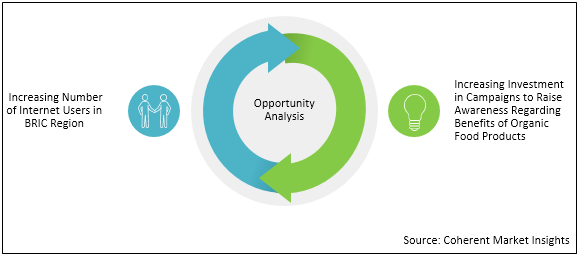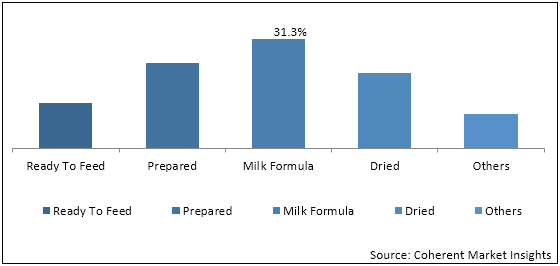Organic baby food is produced from certified organic raw materials and is free from any artificial additives ingredients. Organic food are grown or synthetic fertilizers or pesticides and more nutritious than non-organic food. Organic baby food is ready to use and doesn't require any preparation or refrigeration. Moreover, organic baby food have longer shelf-life and decrease the risk of various a disease that is caused by exposure to pesticides and other contaminants in foods. Organic baby foods keep the limits the exposure of harmful substances during the highly sensitive time of babies' lives. Furthermore, organic baby foods are packed with a high level of antioxidants and vitamins than conventional or non-organic baby food.
The BRIC organic baby food market is projected to reach around US$ 11371.5 million by the end of 2027, in terms of revenue, growing at CAGR of 18.2% during the forecast period (2020-2027).
Drivers:
Easy availability of natural resources in countries of BRIC region, due to high cultivation of raw material which are used to produce organic products. According to the Coherent Market Insights analysis, in the Asia Pacific, Brazil is one of the most prominent countries contributing to organic farming, followed by China. Thus, high cultivation of raw materials used for the production of organic baby food is projected to augment the market growth.
Increasing trade across all sectors in the BRIC region is expected to accelerate the market growth of organic baby food. This can be attributed to the liberalization of trade and increasing investment, which opens lots of space for international trade. According to the Coherent Market Insights analysis, China is highly dependent on imported baby food products, especially milk formula.
On basis of the country, China dominated the BRIC organic baby food market in 2019, accounting for around 59.0 % share in terms of value
Market Restraints
The low shelf life of organic baby food products due to the absence of synthetic preservatives which leads to limited visibility of such products in retail outlets. This is expected to hinder the market growth. Moreover of the lack of brand awareness of this product due to low visibility among consumers, resulting in lower profitability for international vendors in BRIC countries thus restricting the market growth of organic baby food.
Market Opportunities
Growth in internet users has led to growth in E-commerce in Brazil. According to the Coherent Market Insights analysis, 50% of women in Brazil are online shoppers. Moreover, the growth of e-commerce can be attributed to increased access to broadband, coupled with falling prices of computers and smartphones. This is projected to help organic baby food manufacturers to target potential consumers and serve them products at competitive rates.
Governments and key organic food manufactures are increasing investment in educating consumers by campaigns to raise awareness regarding the health benefits of natural and chemical-free food products. This has increased demand for organic food products across countries of the BRIC region. This is projected to accelerate the market growth of organic baby food over the forecast period.
Figure 1. BRIC Organic Baby Food Market– Opportunity Analysis

To learn more about this report, Download Free Sample
Market Trends
Product innovation by manufacturers is a trend in the BRIC organic baby food market and this is expected to fuel the market growth. For instance, in May 2019, Nestle launched an organic product within its Ceregrow brand of cereals for children over the age of 12 months, made from 100% organic ragi, wheat, milk, and rice. The product is produced at the company’s Samalkha factory in Haryana (India), using locally grown ingredients.
Figure 2. BRIC Organic Baby Food Market, Revenue Share (%), By Product Type, in 2019
To learn more about this report, Download Free Sample
On the basis of product type in 2019, the milk formula segment has accounted the largest market share of 31.3% in terms of value, followed by prepared type and dried type respectively.
Competitive Section:
Company Names
Share
Share
Missing comfort of reading report in your local language? Find your preferred language :
Transform your Strategy with Exclusive Trending Reports :
Frequently Asked Questions
Select a License Type
Joining thousands of companies around the world committed to making the Excellent Business Solutions.
View All Our Clients